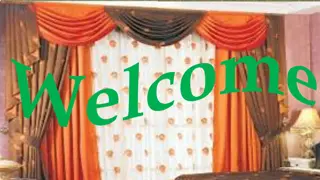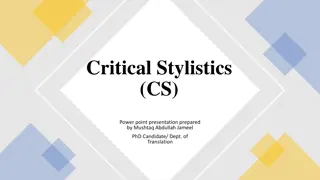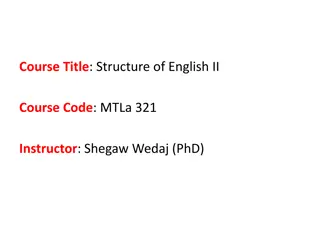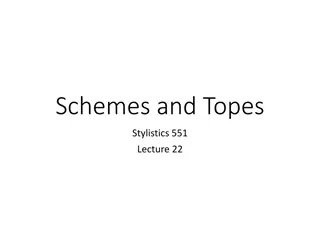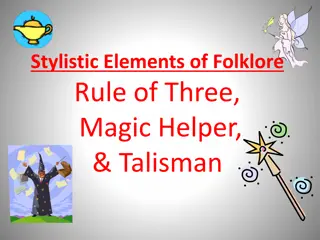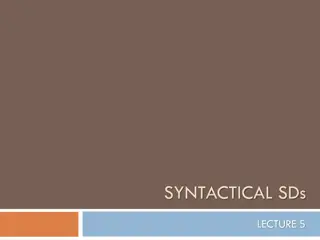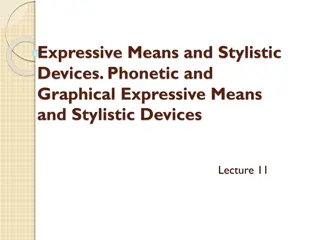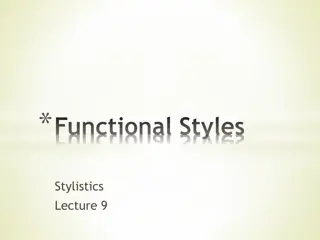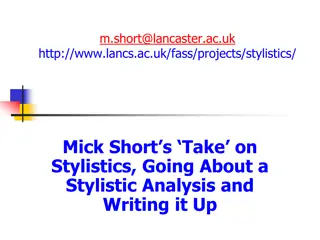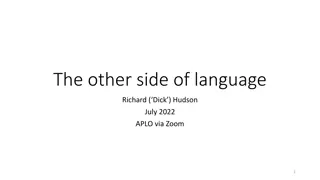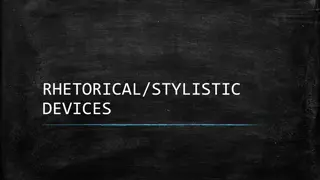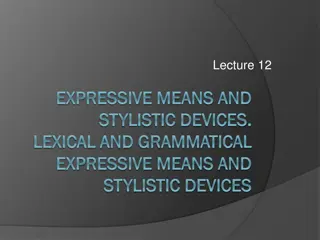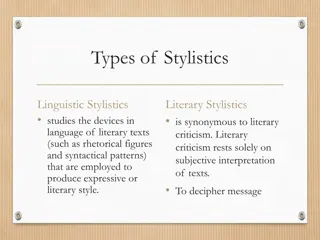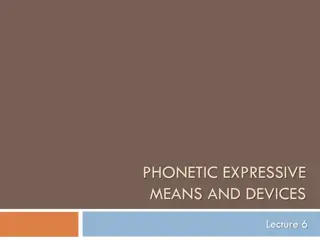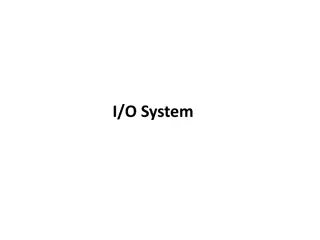An Exploration of Stylistics in Linguistics: Expressive Means and Stylistic Devices 2. Stylistics as a branch of linguistics examines expressive means and stylistic devices which enhance the emotive and aesthetic qualities of language. These include
Stylistics, Linguistics, Expressive Means, Stylistic Devices, Language
Download Presentation

Please find below an Image/Link to download the presentation.
The content on the website is provided AS IS for your information and personal use only. It may not be sold, licensed, or shared on other websites without obtaining consent from the author.If you encounter any issues during the download, it is possible that the publisher has removed the file from their server.
You are allowed to download the files provided on this website for personal or commercial use, subject to the condition that they are used lawfully. All files are the property of their respective owners.
The content on the website is provided AS IS for your information and personal use only. It may not be sold, licensed, or shared on other websites without obtaining consent from the author.
E N D
Presentation Transcript
STYLISTICS AS A BRANCH OF LINGUISTICS STYLISTIC DEVICES AND EXPRESSIVE MEANS
Outline 1. The notion of expressive means and stylistic devices 2. Phonetic stylistic devices 3. Morphological stylistic devices 4. Lexical stylistic devices (tropes) 5. Syntactic stylistic devices 6. Lexico-syntactic stylistic devices
Expressive means EM phonetic, morphological, lexical and syntactic units and forms which make speech emphatic, introduce connotational meanings into utterances phonetic EM pitch, melody, stress, pauses, whispering, singing and other ways of using human voice morphological EM emotionally coloured suffixes of diminutive nature, e.g. sonny, auntie, streamlet, duckling lexical EM words possessing connotations: epithets, poetic and archaic words, slang, vulgarisms, interjections syntactic EM emphatic syntactic constructions, e.g. John went away. Away went John.
Stylistic devices/ tropes/ figures of speech NOT language phenomena Formed in speech Do NOT exist out of context Used to express abstract emotional or philosophical concepts, create powerful and dynamic communication A stylistic device is a deliberate intensification of some typical structural and/or semantic property of a language unit, aimed at achieving a special effect.
Language levels and language units Language level Language unit Phonemic A phoneme Morphemic A morpheme Lexical A word Syntactic A sentence
The phonemic level phonetic stylistic devices: - alliteration - assonance - onomatopoeia - rhyme - rhythm
Phonetic stylistic devices Alliteration repetition of consonant sounds in close succession in order to impart a melodic effect to the utterance; often used in proverbs and set expressions, literary titles, poetry: e.g. cool as a cucumber, as slow as a snail, safe and sound, Pride and Prejudice (J. Austin). No longer mourn for me when I am dead (Shakespeare s sonnet) Assonance repetition of vowel sounds (usually in stressed syllables) in the neighbouring words, e.g. A black cat in a black hat. Twinkle, twinkle, little star, How I wonder, what you are, Up above the world so high, Like a diamond in the sky (Children s Rhymes).
Phonetic stylistic devices Onomatopoeia using words which include sounds similar to the noises that the words refer to, in order to imitate certain sounds of the outer world, e.g. ding- dong, cuckoo, boom, knock-knock - onomatopoeic verbs denoting sounds produced by certain animals: doves coo, flies buzz, hens cluck/cackle, ravens croak, tigers roar, cats mew/purr, magpies chatter Rhyme the repetition of identical or similar final sound combinations of words usually placed at the end of lines. We say these words rhyme if they have the same last sound, e.g. Humpty Dumpty sat on a wall, Humpty Dumpty had a great fall. English proverbs often have rhyming words, too, e.g. An apple a day keeps the doctor away. A stitch in time saves nine. The proof of the pudding is in the eating.
Phonetic stylistic devices Rhythm (esp. in poetry) a strong pattern of words, which brings order into the utterance, e.g. the following well-known verse does not abound in rhyming words, yet it is rhythmically well-organized: This is the house that Jack built. This is the malt that lay in the house that Jack built. This is the rat that ate the malt that lay in the house that Jack built. This is the cat that chased the rat that ate the malt that lay in the house that Jack built. Graphon a deliberate corruption of the graphical form of a word or an utterance aiming at conveying the exact pronunciation of the speaker = a word or a phrase is misspelt to show that it is mispronounced. It is typical of the personage s speech, e.g. Schcuse me (= .Excuse me ), wery (=very, the v-w substitution is characteristic of Cockney dialect).
Morphological stylistic devices intentional repetition of morphemes, e.g. He was unselfish, unhealthy, unmindful, and unclean. occurrence of a morpheme in a grammatically unusual context, e.g. - the plural of abstract nouns used only in the singular, e.g. Oh! Winfrid has emotions, hates, pities, wants at least sometimes. - the use of articles with personal names, e.g. I know a Tommy Flynn. You are not the Andrew Manson I married. - expressive use of degrees of comparison, e.g. You cannot be deader than the dead. - emotionally coloured suffixes of diminutive nature (expressive means), e.g. sonny, auntie, streamlet, duckling
Lexical stylistic devices / tropes based on the interaction of types of meaning Traditionally, the following types of meaning are distinguished: - logical meaning (registered in dictionaries), - emotional meaning (showing a negative/ positive attitude of a speaker towards the object of speech), - nominal meaning (characteristic of proper names, which lack logi- cal meaning), and - contextual meaning (which is acquired by the word in a text).
Types of meaning interaction logical+ contextual metaphor logical+ emotional logical+ logical logical+nominal hyperbole zeugma antonomasia metonymy pun epithet violation of a phraseological unit semantically false chains nonsense of non-sequence oxymoron irony simile
Lexical stylistic devices / tropes antonomasia violation of phraseological unit metaphor semantically false chains metonymy nonsense of non-sequence irony hyperbole zeugma epithet, simile pun oxymoron
Lexical stylistic devices / tropes Antonomasia (=renaming) - metaphorical transference of meaning when a personal name is used instead of a common noun and vice versa, e.g. Her husband is a real Casanova. I suspect that the Noes and Don t Knows would far outnumber the Yesses. Antonomasia is widely used when book characters are given names which are called "speaking" or "telling" names: Becky Sharp, Lady Deadlock,
Lexical stylistic devices / tropes metaphor transference of meaning from one word to another (qualities of one object are transferred to another), e.g. The leaves fell sorrowfully. An uneasy day died away. The flood of tears metonymy the use of one word for another, based on the relations of association or partition, e.g. He earns his living with his pen (association with occupation); The other day she bought a Picasso (contiguity between two objects); The kettle is boiling (the container implies its content). irony expresses the opposite of what the words really mean: There was heavy traffic of three Fords in the street.
Lexical stylistic devices / tropes zeugma is based upon the interaction of a free and a phraseological meanings of words: She had a yellow dress and a cold in her head (to have a dress - a free word combination; to have (a) cold - a set expression). , , . pun - two different meanings of one and the same word interact: Cancer is just a word, not a sentence. What s black and white and red (=read) all over? A newspaper . violation of a phraseological unit: Never put off till tomorrow what you can eat today. semantically false chain (represented by a number of homogeneous members semantically disconnected, yet attached to the same head), e.g. A governess is wanted. Must possess knowledge of Russian, French, Italian, Spanish, German and mining engineering.
Lexical stylistic devices / tropes non-sense of non-sequence - two semantically disconnected clauses are joined into one sentence, e.g. y .: , . hyperbole is based on intended exaggeration of some qualities: She cried buckets. He was so tall that I was not sure he had a face (O Henry). epithet expresses an emotionally coloured subjective evaluation; based on the interplay of emotive and logical meaning in an attributive word or phrase: a broken heart, a tired old town, a wild wind simile expresses partial sameness of two objects which belong to entirely different classes of things, e.g. the child seems to be as clever as his mother vs Maidens, like moths, are caught by glare. oxymoron - a combination of two words with opposite meanings: A bitter sweet experience. An awfully pleasant face.
Syntactic stylistic devices based on peculiarities of the syntactic organization of the utterance. polysyndeton asyndeton inversion rhetorical question ellipsis detachment aposiopesis parallelism lexical repetition chiasmus parenthesis syntactic tautology parcelling
Syntactic stylistic devices Inversion is the change of the grammatically normal word order in a sentence. The aim is to add logical stress or emotional colouring to the utterance: Never have I heard a weaker excuse! So devastating were the floods that some areas may never recover. rhetorical question - an emotional statement or negation structured as a question. It needs no answer: Why do these things always happen to me? ellipsis is dropping out of one or both main parts of a sentence on condition that their meaning is easily restored from the context; used to imitate colloquial language: "Had a good time? "Scared, kid? "Want me to stay with you?" "Never heard of . detachment is a deliberate placement of one of the sentence parts to the final position in the sentence: "I want to go , he said, miserable (J. Galsworthy). (=he was miserable). She was weeping for the loss of her husband. Bitterly.
Syntactic stylistic devices aposiopesis the break in the narrative, used to express an (over)emotional state of the speaker): Well, I never! Well, I declare! Well, it depends... lexical repetition is a repeated usage of some part of a sentence or phrase: Nothing ever happened in that little town, left behind by the advance of civilization, nothing. parallelism is based on similar structural building of two or more sentences or their parts: No man is ever too old to look at a woman, and no woman is ever too fat to hope that he will look. chiasmus is reversed parallelism, i.e. the repeated parts change their syntactical function according to the model A B: B A, e.g. It was a shock to me that while I observed Thompson, Thompson observed me. He loves her, and she adores him.
Syntactic stylistic devices The arrangement of sentence members necessarily involves various types of connection within a sentence and/or between sentences. The repeated use of conjunctions or other connectives in close succession adds rhythm to the utterance. This stylistic device is known as polysyndeton: The heaviest rain, and snow, and hail, and sleet could boast of the advantage over him in only one respect. A deliberate omission of conjunctions is asyndeton. Asyndeton makes the narration measured and energetic, e.g. Who makes fame? Critics, writers, stockbrokers, women.
Syntactic stylistic devices Paranthetic sentences grammatically independent of a bigger sentence they are used in. They express additional information which emphasizes sth or makes the utterance more detailed, e.g. They had not seen no one could see her distress, not even her grandfather. Syntactic tautology is based on the repetition of words which are in meaning and grammatically synonymous within one sentence, e.g. The widow Douglas, she took me for her son. Parcelling the structure of the sentence is deliberately split into several parts, which are separated from each other with full stops, e.g. Jane hates her boss. Very much.
Lexico-syntactic stylistic devices both the arrangement of elements within an utterance and their meaning are important. They include: Climax / gradation presents a structure in which every next sentence or phrase is emotionally stronger and/or are logically more important than the previous one, e.g. For a moment she felt she was lonely. In the room, in the house, in the whole world. anticlimax / antigradation aims at achieving a humorous effect by a sudden break in the accumulation of logical importance, e.g. Women have a wonderful instinct about things. They can discover everything, except the obvious. (O. Wilde)
Lexico-syntactic stylistic devices antithesis syntagms, e.g. She had a large house and a small husband. (B. Shaw) periphrasis substitution of a word by a phrase or a word combination to draw the reader s attention to certain qualities of the object, e.g. the better sex (women), Ladies and worse halves! (=gentlemen); euphemism as a variety of periphrasis, is used to substitute a generally accepted word for decency sake, e.g. 'senior citizen is a euphemism for an old person ; to join the majority means to die . is the opposition of two concepts in neighbouring
Reference literature . ., . . . .- .: - , 2004. . . . : , 2009. 128 . . ., . . : - . : , 2011. 240 . . . : - . . 2- , . : , 2006. 132 . . ., . . . - . : , 2015. 200 .



